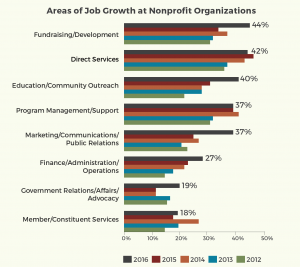
The signs of a healthy nonprofit sector remain strong. According to the annual Nonprofit Employment Practices Survey produced by the human resources consulting firm Nonprofit HR, most nonprofits (57 percent) say they plan to create new positions in 2016. This is a six percent increase over 2015.
 Many nonprofits believe this year they will see job growth in fundraising and development positions (44 percent). Direct services (42 percent) as well as education and community outreach (40 percent) positions also placed high on the list of growth areas.
Many nonprofits believe this year they will see job growth in fundraising and development positions (44 percent). Direct services (42 percent) as well as education and community outreach (40 percent) positions also placed high on the list of growth areas.
“The last few years this survey has validated the strength of the nonprofit sector as it continues to grow, outpacing the corporate sector and holding its spot as the third largest employer in the country,” said Nonprofit HR CEO Lisa Brown Morton. “That said, nonprofits are competing with the corporate sector for top talent. As the sector continues to experience growth and jobseekers have more options to choose from, the lack of formal recruitment and retention strategies will become an even more serious challenge to the sector. This dynamic has the potential to negatively impact nonprofits’ ability to effectively achieve their missions in the future.”
The report indicates that the nonprofit sector is not immune to the same recruitment and retention deficits as any employer. For example:
- 33 percent of those surveyed indicated an inability to hire qualified staff within a limited budget as a top staffing challenge
- 54 percent say they do not have a formal recruitment strategy
- 71 percent do not have a formal recruitment budget
Reinforcing the sector’s difficulties with recruitment and retention is that it continues to lag the private sector in employee compensation. For example the recent Northeast Florida Nonprofit Compensation and Benefits Report produced annually by the Nonprofit Center of Northeast Florida shows that more than 70 percent of employees leading and staffing nonprofits in northeastern Florida are women. But there is an obvious gender pay gap within the sector (as there is across industries) on top of the usual minor deficiencies in nonprofit pay versus for-profit pay.
Beth Reese Cravey expanded on this point in her recent article published in the Florida Times-Union.
There is a CEO wage gap in the nonprofit and private sectors — 13 percent, compared to 20 percent — and in both workplaces salaries of the lowest-paid employees hover around the poverty line.
The median annual base pay for nonprofit CEOs and executive directors across Northeast Florida is $99,904 — the median for men, $110,423; for women, $96,000. While 69 percent of the top leaders are women, “a relatively larger portion of men are in the CEO/executive director positions of the largest organizations, which tend to pay higher wages,” according to the [Nonprofit Center of Northeast Florida] report.
“It’s disappointing on many levels given the complexity of effectively leading a nonprofit,” said Lelia Duncan, president and CEO of Community Connections of Jacksonville. “It has become more critical than ever to attract and retain the best and brightest, regardless of gender. Equal pay is instrumental in making that happen.”
So how do nonprofits compete? Outside the need for better recruiting and engagement strategies (watch: How Nonprofits Can Flourish with Employee Engagement), one answer maybe Millennials.
Hadley Malcolm at USA TODAY explains:
When it comes to looking for a new job, a majority of young adults say a better quality of life at work is more important than a fatter salary, according to a survey out this month from Fidelity. In fact, 25- to 35-year-olds [Millennials] said they’d be willing to give up an average of $7,600 in pay for a better situation at the office, such as more career development and a healthier work/life balance.
And employers, take heed: Even though most Millennial employees are happy at work — 86% — nearly half are actively looking for a new job, or at least open to new opportunities.
The data point out just how far the country’s largest workforce is willing to go in pursuit of a meaningful career over a cozy paycheck.
So there it is. A sector looking for energetic new talent that will work for a less than “average” salary and a whole generation actively looking for a healthier workplace regardless of compensation. Now to just get that sector-wide recruitment strategy up and running…
Note: Need low cost recruitment tools? Watch: Low Cost Recruiting Tools for Nonprofits




